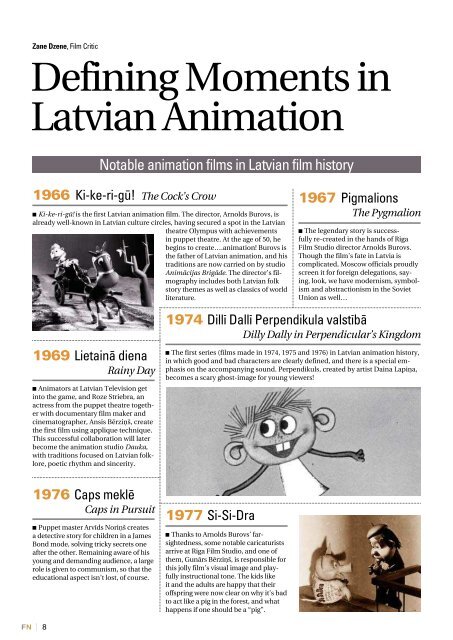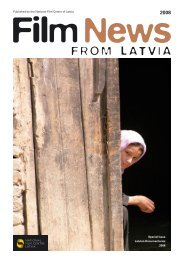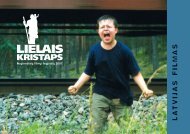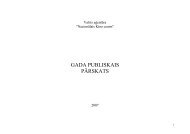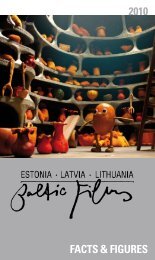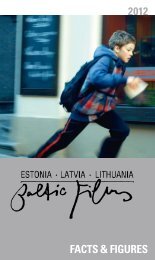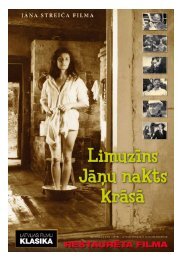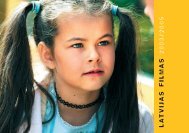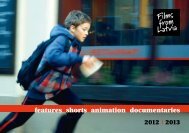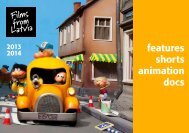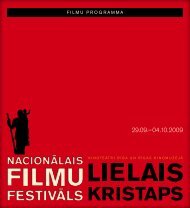Latvian Animation - NacionÄlais Kino centrs
Latvian Animation - NacionÄlais Kino centrs
Latvian Animation - NacionÄlais Kino centrs
Create successful ePaper yourself
Turn your PDF publications into a flip-book with our unique Google optimized e-Paper software.
Zane Dzene, Film Critic<br />
Defining Moments in<br />
<strong>Latvian</strong> <strong>Animation</strong><br />
Notable animation films in <strong>Latvian</strong> film history<br />
1966 Ki-ke-ri-gū! The Cock’s Crow<br />
■ Ki-ke-ri-gū! is the first <strong>Latvian</strong> animation film. The director, Arnolds Burovs, is<br />
already well-known in <strong>Latvian</strong> culture circles, having secured a spot in the <strong>Latvian</strong><br />
theatre Olympus with achievements<br />
in puppet theatre. At the age of 50, he<br />
begins to create….animation! Burovs is<br />
the father of <strong>Latvian</strong> animation, and his<br />
traditions are now carried on by studio<br />
Animācijas Brigāde. The director’s filmography<br />
includes both <strong>Latvian</strong> folk<br />
story themes as well as classics of world<br />
literature.<br />
1969 Lietainā diena<br />
Rainy Day<br />
■ Animators at <strong>Latvian</strong> Television get<br />
into the game, and Roze Striebra, an<br />
actress from the puppet theatre together<br />
with documentary film maker and<br />
cinematographer, Ansis Bērziņš, create<br />
the first film using applique technique.<br />
This successful collaboration will later<br />
become the animation studio Dauka,<br />
with traditions focused on <strong>Latvian</strong> folklore,<br />
poetic rhythm and sincerity.<br />
1976 Caps meklē<br />
Caps in Pursuit<br />
■ Puppet master Arvīds Noriņš creates<br />
a detective story for children in a James<br />
Bond mode, solving tricky secrets one<br />
after the other. Remaining aware of his<br />
young and demanding audience, a large<br />
role is given to communism, so that the<br />
educational aspect isn’t lost, of course.<br />
1974 Dillī Dallī Perpendikula valstībā<br />
Dilly Dally in Perpendicular’s Kingdom<br />
■ The first series (films made in 1974, 1975 and 1976) in <strong>Latvian</strong> animation history,<br />
in which good and bad characters are clearly defined, and there is a special emphasis<br />
on the accompanying sound. Perpendikuls, created by artist Daina Lapiņa,<br />
becomes a scary ghost-image for young viewers!<br />
1977 Si-Si-Dra<br />
■ Thanks to Arnolds Burovs’ farsightedness,<br />
some notable caricaturists<br />
arrive at Riga Film Studio, and one of<br />
them, Gunārs Bērziņš, is responsible for<br />
this jolly film’s visual image and playfully<br />
instructional tone. The kids like<br />
it and the adults are happy that their<br />
offspring were now clear on why it’s bad<br />
to act like a pig in the forest, and what<br />
happens if one should be a “pig”.<br />
1967 Pigmalions<br />
The Pygmalion<br />
■ The legendary story is successfully<br />
re-created in the hands of Riga<br />
Film Studio director Arnolds Burovs.<br />
Though the film’s fate in Latvia is<br />
complicated, Moscow officials proudly<br />
screen it for foreign delegations, saying,<br />
look, we have modernism, symbolism<br />
and abstractionism in the Soviet<br />
Union as well…<br />
1978 Vanadziņš The Hawk<br />
■ Undoubtedly one of the all-time most beautiful <strong>Latvian</strong> animation films - the<br />
screenplay is based on themes from the stories of writer Vilis Lācis, and depicts the<br />
relationship between a small boy and<br />
his father – a seaman. The emotional<br />
portraits included in Arnolds Burovs’<br />
direction lend this tragedy the ache of<br />
human drama.<br />
1983 Kabata<br />
In My Pocket<br />
■ Latvia’s first animation film drawn<br />
on celluloid is based on themes from<br />
<strong>Latvian</strong> poet Ojārs Vācietis’ children’s<br />
poems, with a musical score by Imants<br />
Kalniņš.<br />
1991 Gulbis Swan<br />
■ Gulbis marks the beginning of Studio<br />
AB’s Avārijas Brigāde (Rescue<br />
Team) series, which quickly gains<br />
popularity not only in Latvia but also<br />
far beyond the borders, and rather<br />
convincingly showcases the talent and<br />
ability of the young artists who have<br />
come from the Arnolds Burovs’ school.<br />
The three main characters - Sīlinks,<br />
Poteriks and Bembelāts – “lend” their<br />
faces to local manufacturers for advertising<br />
purposes, and entertain viewers<br />
with their imagination and the turns<br />
of events that befall them. Soon after,<br />
Studio AB creates two more series –<br />
Munks un Lemijs (Munk and Lemmy)<br />
and Zvēri (Animals). Later on, together<br />
with the Danish studio Zentropa, they<br />
make two animated features – Props<br />
un Berta (Prop and Berta) and Trīs<br />
Musketieri (The Three Musketeers).<br />
All around success!<br />
Čapliniāna.<br />
1983 Sapnis<br />
The Dream<br />
1984 Pēdējā lapa<br />
The Last Leaf<br />
1986 Princese un<br />
puma The Princess and<br />
the Puma<br />
1981 Bimini<br />
■ A visualisation of the reflections and<br />
ideas on a poem by Heinrich Heine –<br />
the film’s title was also borrowed for<br />
a while by the only <strong>Latvian</strong> animation<br />
festival. That is long gone, but this<br />
Arnolds Burovs’ film has become a<br />
<strong>Latvian</strong> animation classic, and the music,<br />
composed by Imants Kalniņš and<br />
performed by Menuets, beckons us to a<br />
wonderland called Bimini, where there<br />
is eternal spring, and a drink from the<br />
brook’s water grants all wishes, such as<br />
restoring youth.<br />
■ Charlie Chaplin said: he’s a citizen<br />
of the world, and perhaps that is why<br />
the famous character, The Tramp, appealed to Arnolds Burovs and his team. After<br />
returning from America, Burovs is completely taken with the works of O. Henry,<br />
and begins to make films based on what he’s seen across the ocean. The events<br />
and characters are, of course, given comic notes and sentiments, which are nicely<br />
underscored by maestro Raimonds Pauls’ music.<br />
1991 Ness un Nesija Ness and Nessy<br />
■ A collaboration between almost all<br />
forces of <strong>Latvian</strong> animation creates<br />
the first <strong>Latvian</strong> animated feature -<br />
a love story based on the legendary<br />
Loch Ness Monster. Many sayings<br />
from this film have become part of<br />
spoken <strong>Latvian</strong>, but the likable hero’s<br />
name, Knipucītiņuminītiņimais<br />
Pintiķupinītis, isn’t even pronounceable.<br />
In 1993, Ness un Nesija receives<br />
a Lielais Kristaps award for best animation<br />
film.<br />
FN | 8 FN | 9


